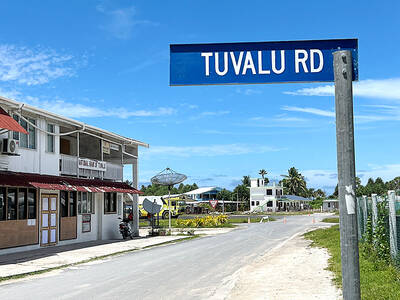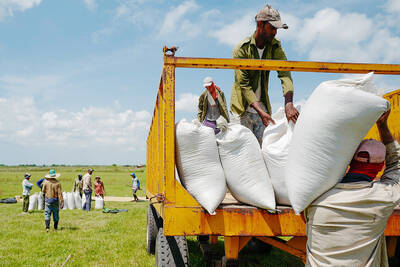The big rigs rattling past smokestacks sure do not make this Chicago roadway look like the greenest street in the US. However, their tires roll over smog-eating pavement, the streetlights run on solar and wind power, the sidewalks were made with recycled concrete and shrub-filled “bioswales” keep storm water out of overtaxed sewers.
“Sustainability is critical for us,” said Karen Weigert, chief sustainability officer for the city of Chicago. “We think of it as a part of quality of life, about economic opportunity in terms of what kinds of jobs we attract and about stewardship of tax dollars.”
Chicago has been experimenting with greener approaches to urban planning for years as part of a broader plan to mitigate the impacts of climate change: more intense storms and more extreme temperatures.
The US$14 million project to reshape 3.2km of the industrial Pilsen neighborhood incorporates pretty much everything city planners could come up with to cut energy use, fight pollution, reduce waste, manage water use and help build a sense of community.
Amazingly, it cost 21 percent less than a traditional road resurfacing project and is expected to be cheaper to maintain.
“These are all critical issues for cities to address,” said Karen Hobbs, a water analyst with the Natural Resources Defense Council.
Heavy rain washes pollution off roofs, roads and parking lots, which too often ends up in rivers and lakes that supply drinking water. If the storm drains get flooded, raw sewage can also end up in the mix.
Planting more trees, shrubs and grass belts does not only help keep rain out of the sewers, it also helps capture carbon dioxide, reduces the “heat island” effect of sun-soaked asphalt and generally makes a neighborhood more pleasant.
Improving public transportation and adding bicycle lanes reduces congestion while cutting pollution, which also improves quality of life.
Cutting energy by using more efficient street light bulbs or installing the mini solar and wind power stations not only helps reduce emissions, but also saves money.
Chicago is one of a growing number of cities that are no longer waiting for the US federal government to deal with climate change and are instead finding local, “no-regret” solutions, Hobbs said.
“In other words, activities that save its residents and businesses money, improve quality of life and, as an added bonus, reduce emissions,” she added.
Chicago says it is the first in the nation to lay down smog-eating cement.
The seemingly magical material was first developed when the Vatican wanted to build a church to celebrate the 2,000th anniversary of Christianity that would stay white in the face of Rome’s pollution.
Italian cement giant Italcemeti developed a product that uses titanium dioxide to set off a chemical reaction with sunlight that essentially cleans the surface of the church by speeding up the decomposition process.
They discovered that it was not just cleaning the grime off the Dives in Misericordia church, it was also cleaning the air up to 2.5m above the roof’s surface.
Because it is significantly more costly than traditional pavement, Chicago is using it in thin, permeable pavers for the bicycle and parking lanes along Blue Island Avenue and Cermak Road.
Project manager Janet Attarian insists that while the smog-eating pavers are pretty impressive, it is the combined approach that is going to make a real difference.
“I really hope this project inspires people to think about the full range of opportunities that are available,” Attarian said during a site visit.
“We tend to take the roads for granted, like ‘oh, it’s just a road what can we do about it.’ But there’s actually quite a bit,” she added.
Reducing the storm water impact on sewers by as much as 80 percent means the city can hopefully prevent, or at least delay, multimillion-dollar upgrades to its aging system.
Recycling 60 percent of the project’s construction waste and sourcing 23 percent of new materials from recycled content means less pressure on the city’s landfills and showed local contractors a new way to cut costs.
Choosing drought-resistant plants for the bioswales means they ought to be able to withstand the hotter summers forecast as a result of climate change without wasting fresh water.
Other details are more focused on building community, like benches near a pond that captures storm water from a high school roof and courtyard, new shelters at the bus stops and signs up and down the street describing the project.
The city is currently drafting new guidelines that will incorporate many of these green approaches as requirements for any new road work going forward.
“These infrastructure projects last for 50, 100 years so you can’t afford to redo them again when you finally figure them out,” Attarian said. “You have to be designing for the future, not just the present.”

FORUM: The Solomon Islands’ move to bar Taiwan, the US and others from the Pacific Islands Forum has sparked criticism that Beijing’s influence was behind the decision Tuvaluan Prime Minister Feletei Teo said his country might pull out of the region’s top political meeting next month, after host nation Solomon Islands moved to block all external partners — including China, the US and Taiwan — from attending. The Pacific Islands Forum (PIF) leaders’ meeting is to be held in Honiara in September. On Thursday last week, Solomon Islands Prime Minister Jeremiah Manele told parliament that no dialogue partners would be invited to the annual gathering. Countries outside the Pacific, known as “dialogue partners,” have attended the forum since 1989, to work with Pacific leaders and contribute to discussions around

END OF AN ERA: The vote brings the curtain down on 20 years of socialist rule, which began in 2005 when Evo Morales, an indigenous coca farmer, was elected president A center-right senator and a right-wing former president are to advance to a run-off for Bolivia’s presidency after the first round of elections on Sunday, marking the end of two decades of leftist rule, preliminary official results showed. Bolivian Senator Rodrigo Paz was the surprise front-runner, with 32.15 percent of the vote cast in an election dominated by a deep economic crisis, results published by the electoral commission showed. He was followed by former Bolivian president Jorge “Tuto” Quiroga in second with 26.87 percent, according to results based on 92 percent of votes cast. Millionaire businessman Samuel Doria Medina, who had been tipped

Outside Havana, a combine belonging to a private Vietnamese company is harvesting rice, directly farming Cuban land — in a first — to help address acute food shortages in the country. The Cuban government has granted Agri VAM, a subsidiary of Vietnam’s Fujinuco Group, 1,000 hectares of arable land in Los Palacios, 118km west of the capital. Vietnam has advised Cuba on rice cultivation in the past, but this is the first time a private firm has done the farming itself. The government approved the move after a 52 percent plunge in overall agricultural production between 2018 and 2023, according to data

ELECTION DISTRACTION? When attention shifted away from the fight against the militants to politics, losses and setbacks in the battlefield increased, an analyst said Recent clashes in Somalia’s semi-autonomous Jubaland region are alarming experts, exposing cracks in the country’s federal system and creating an opening for militant group al-Shabaab to gain ground. Following years of conflict, Somalia is a loose federation of five semi-autonomous member states — Puntland, Jubaland, Galmudug, Hirshabelle and South West — that maintain often fractious relations with the central government in the capital, Mogadishu. However, ahead of elections next year, Somalia has sought to assert control over its member states, which security analysts said has created gaps for al-Shabaab infiltration. Last week, two Somalian soldiers were killed in clashes between pro-government forces and